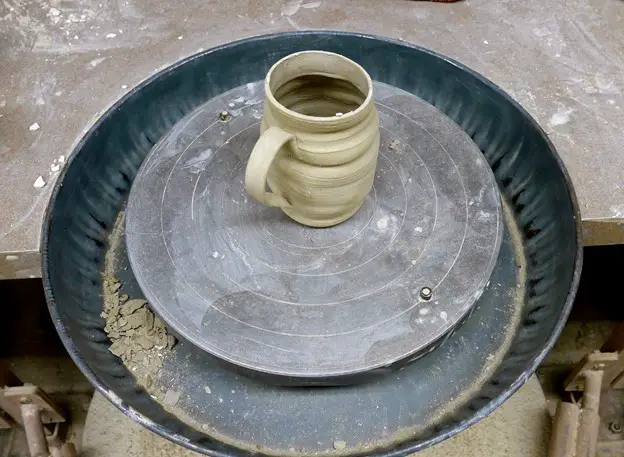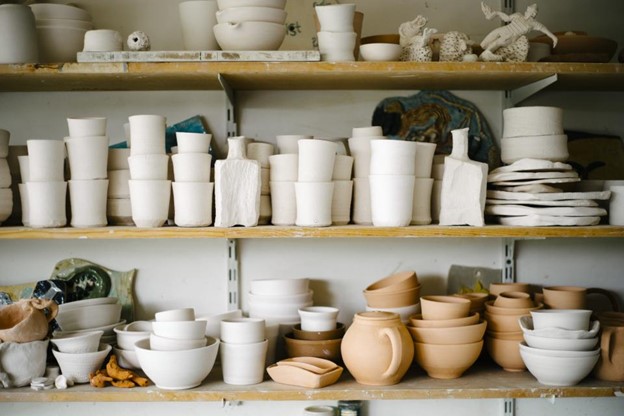Pottery can seem intimidating for beginners. With a plethora of technical terms & never seen before tools to work with, you might feel puzzled with no clear direction. So, if you are looking for a quick head start and need some advice on the best ways to get started, it is important to figure out the basics first. Today, we will learn all about the basic pottery equipment for beginners. This can help you check off some important mandates from the to-do list when learning pottery.
So, without further ado, let u get started.
Important Pottery Equipment For Beginners

Pick A Reliable Pottery Wheel
Another critical piece of equipment on this list is the pottery wheel. When working in a limited space, it is important to stick to smaller electric pottery wheels. If you are a beginner, even a small-sized pottery wheel will work just as well as a big one.
Once you have mastered the art and understood the basics of stability, you can get yourself a pottery wheel with high torque. For most beginners, variable control over the wheel speed is very important. Certain wheels feature gear systems that provide multiple speed increments. Your pottery wheel might also feature reversing option. This is ideal for left-handed individuals that can create pieces with better precision in the anti-clock direction.
If you are seeking something nostalgic, you can, of course, go with kick wheels. However, they can be very tedious to operate and time-consuming as well. So, if you don’t want to wear yourself out, the key is to prefer electric ones over the traditional kick wheels.
Although electric wheels are a bit on the expensive end, they are well-suited for beginners. They give you complete control over rotational speed, foot pedal, and even the wheel head. If you are planning on purchasing your first electric pottery wheel, make sure you check for elements such as:
- Better motor control
- Well-designed splash pan
- Proper centering capacity
- Wheelhead
- Dimensions/weight
- Body material
A great option with all these features is the SKYTOU Pottery Wheel with a reliable foot pedal. Featuring an ABS basin, this clay shaping equipment can rotate at speed starting at 0 and going all the way to 300RPM.
Get Your Very First Kiln
When looking for the right kiln for your pottery necessities, you don’t necessarily have to go for the biggest one available. The key is to start with a small and portable kiln that does the job of firing clay as efficiently as a big one.
A small kiln is generally portable and can easily be plugged into your standard home sockets. On the other hand, larger kilns must be wired into your system’s mains with the help of an electrician. With smaller kilns, firing is more frequent. This is especially helpful if you wish to fire a small batch and don’t want to leave any empty space in the kiln, which could be a waste of energy.
Smaller kilns are ideal for beginners who work with smaller batches. They are pocket-friendly as well. You can also opt for used kilns. However, you need to ensure that the firing elements and firebricks are in an optimum condition. Any used kiln will surely have some level of degradation. However, any major crack in its base or lid should be a big no when it comes to the purchase part.
Kilns tend to wear out each time something is fired inside. After a certain period of time, it would have to be replaced. If you don’t wish to deal with these hassles, you can get a new kiln. You can find a pocket-friendly option without having to compromise on the quality factor.
Given the fact that kilns have to be operated at an extremely high temperature, make sure you keep them inside a garage or any external part of your house. You also need to ensure that there are no flammable items in the close vicinity of the kiln. This will ensure that there isn’t an accidental fire in your vicinity.
Let us learn more about the elements inside an electric kiln and how they help!
| Parts | Use-Case |
| Reflective Coating | It helps protect the firing bricks & seals the pores |
| Outer Control Panel | It allows for easy servicing of the kiln while keeping the electronics cool and safe |
| DynaTrol | It helps with easy monitoring and programming of the kiln |
| Zone Control | It features 2 to 3 thermocouples that help even out the temperature |
| Extra Insulation | It helps keep the electronics cool |
| Molded Ceramic Terminal | It helps establish better connectivity between the heating elements |
| Ceramic Peephole Plug | It helps keep an eye on the firing process inside with a straight view |
| Hard Ceramic Channels | It helps protect the kiln’s firing elements & the fragile firebrick. It also helps improve the kiln’s life while providing a wider and more reflective heat transmission surface |
Clay Processors
If you love that traditional crafting process, you would want to get access to raw clay. But, how would you prepare it for easy crafting? This is where a clay processor comes in. This equipment helps prepare the clay for your pottery escapades.
This equipment isn’t as important for beginner crafters unless you plan on creating a large volume of pottery pieces. For small batches, you can simply make do with commercial clay available online or at your local shop.
However, creating your own clay for large batches will help you save up a lot in terms of budget. There are 3 prime components of a clay processor that include:
- Pugger mixers
- Clay mixers
- Pugmills
Clay mixers help mix the clay body with the activating ingredients. They can also be used for recycling clay scraps. On the other hand, pugmills help homogenize clay that is mixed with the help of clay mixers. Finally, pugger mixers have the potential to do both.
Conclusion
With these three pieces of equipment by your side, you can start your pottery crafting journey. Make sure you stick to your budget and don’t shop for features that are more than what is necessary to initiate your journey. Remember, it is fine to get stuck at times in your journey to learn something new. The key is not to give up!









